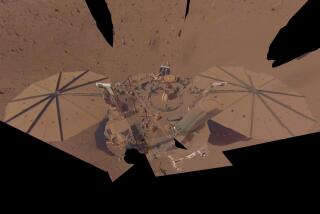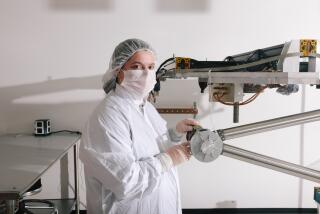No signs of water yet from Mars lander
In its first chemical analysis of soil from Mars’ northern plains, NASA’s Phoenix lander has turned up no evidence of water, scientists said Monday.
Still, researchers remained confident that the craft is in the right place to uncover veins of ice believed to lie only inches beneath the surface.
A soil sample was cooked twice in one of Phoenix’s eight ovens over the past few days, according to William Boynton, lead scientist for the Thermal and Evolved-Gas Analyzer. The first test reached 95 degrees Fahrenheit, while the second went to 350 degrees.
“Had there been any ice, it would have melted,” Boynton said. “We saw no water in the soil whatsoever.”
The instrument detected carbon dioxide, hardly a surprise since the thin Martian atmosphere is primarily made up of CO2.
The goal of the $420-million Phoenix mission is to find out whether Mars is, or ever was, suitable for rudimentary life forms. Phoenix landed near Mars’ north pole May 25.
The science team at the University of Arizona and the Jet Propulsion Laboratory in La Cañada Flintridge were not disappointed by the failure to turn up water on the first test sample. Phoenix’s nearly 8-foot-long robotic arm has only dug into the soil between 2 and 3inches deep, at a region named Dodo-Goldilocks. The ice layer, they said, is likely farther down.
The latest images of the trench from which the soil was taken show light-toned material that the scientists think could be ice protruding from the trench’s side.
“It looks like we clipped the edge of the top of a polygon,” said Ray Arvidson, the lead scientist for the lander’s robotic arm.
The polygonal land forms small mounds bounded by shallow trenches are similar to features that scientists have seen in the Arctic on Earth caused by subsurface ice.
“This could be the tip of the iceberg,” Arvidson said.
The science team will next turn its attention to a region nearby called Wonderland, where it thinks the ice layer is close to the surface.
The TEGA ovens are designed to reach 1,800 degrees because different elements burn off at different temperatures. Tests over the next few weeks should help uncover any water bound up with the minerals, if not water itself, scientists said.
NASA’s twin Mars rovers, Spirit and Opportunity, have found evidence that water was once plentiful in the form of standing lakes and streams on Mars’ surface. Finding and testing water today would help scientists determine whether present-day Mars could be habitable.
The last NASA landers to test for habitability on Mars were the twin Viking probes, which landed in 1976. Neither found any organic molecules that would be a good indicator of Mars’ suitability for life.
That disappointment caused planetary scientists to virtually abandon Mars for two decades, until a new generation of scientists proposed that life-sustaining conditions might be found underground at the poles.
Scientists were encouraged by findings from the gamma ray spectrometer on the orbiting Mars Odyssey spacecraft, which in 2002 detected a large concentration of hydrogen in the top few feet of soil at the pole. Scientists believed that indicated vast quantities of ice underground.
john.johnson@latimes.com






